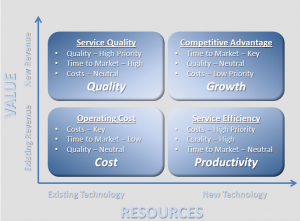This past week Kim S. Nash, Senior Editor for CIO, publshed an insightful article, “Top CIOs Predict the Five-Year Future of the CIO”. I’ll paraphrase a few of the key points that I jotted down and stuck out when I read through the article:
- CIO of the future will be an Entrepreneur, Futurist, Global Talent Scout, Connector, Master of Business Metrics
- CIO / CTO Split? No support for this prediction and fractures the ability to manage / deploy technology and be a strategist
- Big Technology Trends – Cloud, Mobile, Social Media, Consumerization, Big Data, etc. will not change the role
- Manage change, Not Technology
- Set strategy, Not server thresholds
- Technology will change the way a company interacts with it’s customers
- CIO Effectiveness – He/She handles and sparks major business shifts
- Entrepreneur
- In-house futurist, will be measured by financial measure, will run a business and market like the vendors they purchase from
- Set aside technology and focus on business outcomes
- Connector and Futurist
- Will foster partnership with the providers to his company to deliver joint solutions
- How workers, consumers and suppliers will create competitive advantage
- Global Talent Scout
- Roles will change from operators to managers
- Location won’t matter
- Master of Business
- Responsible to create new products and attract new customers, new revenue and thus new accountability
- Innovate
There has been a long standing initiative and talk in the press and analyst papers regarding IT being part of the business and not separate from the business. However, according to the analysts, more than 90% of IT organizations remain reactive and disconnected from the business. I would concur with this. We all attend industry conferences and think about how you answer this question, “What do you do?”. Most of the time when I ask it, the response is something like I manage servers, I manage UNIX servers, I administer databases, I manage the networks, etc. Then I look at their badge, see who they work for and respond with, “Oh you sell insurance or investment banking or ……”.
Before I visit a customer, I do a quick read of their annual report, the letter from the CEO and peruse their website so that when I shake the first hand, I have a fair idea what powers their business. I continue to be surprise by the number of IT technologists that do not know the business their own organization is in or what powers the business, thus setting the easiest to identify priority. Technology without imagination is a commodity, Technology with imagination has endless possibilities, however, most of us act as mere commodity operators keeping the lights on. Keeping the lights on carries an annual cost of 1-2% of revenue, the time has come to power the business and drive with technology.
According to a Gartner and Forbes survey of Board of Directors (BoD), 65% of BoD count on technology to drive competitive advantage for the business and according to IDC >50% of IT will be outsourced by 2013. The role of IT must evolve and it has become an imperative with the advent of competition and new buying models. Competition with the MSPs/ASPs/ISPs, Cloud, SaaS, etc. has arrived and why the business has the buying decisions and is choosing to outsource IT. The time has come to transform and the catalyst is the competition. Kim does a great job describing the role of the CIO and the new face of IT in 5 years.
As a previous analyst in the outsourcing market, I will tell you as I have told many customers, no one outsources for cost. It is a perceived cost reduction. What isn’t factored into the equation is 3-7% of the cost of the contract to manage the relationship and the service and keeping overspending in check. Outsourcing occurs to create change in the environment that is near impossible to do from within. I wait each day for the new Fortune 500 list to arrive and I will hold it to compare with next year’s list. Those that make the transformation to power their business with technology will take leadership spots in their industry’s.
Now let’s talk about what it will take to make this transformation. To achieve the things Kim speaks of, IT must first know what the business is; then how best to use technology to operate it, create competitive advantage, communicate and market results, proactively make real-time changes, and why customers engage to drive future strategy.
What is the Business
In most businesses to drive revenue, you evaluate why customers engage with your organization. In this case, IT in most cases, doesn’t know the business or the services of the business. Step 1 must be to understand the business and current services. I’ve written a previous post on The BSM Hub describing how to categorize and know your services based upon their value to the organization. This will define how you manage these services and the supporting technology. All services are not created equal and thus knowing the services and their relevance to the business is the first step to transforming to Service Managers versus Service Operators.
Here is a true story. I once spoke at a medium sized regional event on the topic of Service Value and managing services in the winter of 2009. After I finished speaking a man approached me and indicated while the discussion was interesting, IT is not strategic to his organization. I looked at his badge and noticed he worked for a candy manufacturer. So my first question was to go after the life blood of the business, the manufacturing line of the candy. “Does IT have anything to do with the manufacturing line?”, the response was “no”. Second question, “I know you must have an ERP system, correct”, “why yes we do…….”. “I venture to guess that sales and distribution to your customers is important business, right?”, “Why yes it is”. Now he is standing taller. I mention how in September 1999 Hershey made the front page of the Wallstreet Journal for the poor deployment of an ERP and CRM system costing them Halloween, Thanksgiving, Christmas, Valentines and most of Easter. The lesson was that the public wasn’t as loyal to chocolate as they are to toothpaste and will buy what is on the shelves at the time. “So managing and providing high availability of your sales, distribution and customer relationship management is critical to your business, wouldn’t you say?”. He left with a different perspective than he came to the conversation with.
Companies are in the headlines everyday due to technology failures pointing out that if you do not know your business and what it costs you to be a mere operator, reacting to incidents, the press and the outsourcers will put value on the situation. The time has come to know the business, the services and their value and the supporting technology in order to manage it accordingly.
How Technology Supports the Business
Now that we know what the business is, let’s take a look at how the technology supports the business. It is no longer sufficient to keep the lights on and manage all equipment the same. Understanding the underlying infrastructure that supports the services defined above will change the way you manage the infrastructure. Priority must be applied, not just severity of an event, business impact will be factored into the management of the technology. Service enabled management in real-time must be applied, it is not a nice to have, but a must have. Given the organization is wasting 1-2% of revenue annually, a service enabling management infrastructure is cheap and paid for before the first year is over.
Many management vendors speak of speed to root cause and speed to restoration. This is still reactionary IT. What is required is real-time, actionable intelligence to do something before a business impacting event occurs and avoid that business impacting event. This now brings me to what many of the financial institutions already know, management is a mission critical service and requires high availability redundancy (as described in a post by my friend Tobin). Don’t believe me? So then I ask this question, “When flying on an airplane, do you want the pilot flying without instrumentation?, Then why would you run your business without instrumentation?”.
Now that you know the business and how your current technology maps to those services, it’s time to evaluate the best technologies and deployment options for the services and service enable them with management upfront, not as an afterthought. Again, go back to the quadrant of services I described earlier. Just because you have capability in-house to deliver commodity services, that isn’t generally the best choice. Outsource the commodity. Keep the competitive expertise in-house and evolve to manage services and put the proper instrumentation in place to service enable the infrastructure to mitigate risk, provided controlled risk for speed to market and provide the real-time actionable intelligence to make shifts on the fly to keep business running and creating quality customer experiences.
Why Customers Engage
Now that you have a grasp on today, let’s now use this new service enabled infrastructure to start creating the strategy to provide stickiness with your customers, improve the customer experience with technology, creates competitive advantage and driving revenue. This evaluation is 2 fold: keeping current customers and gaining new customers. Look at how customers want to do business with you, what devices they use, where and when they conduct business, etc. and often times creating a higher quality of service to maintain current customers will drive gaining new customers.
True innovation changes how an industry does business, think of eBay in the early days. These sorts of transformations are rare, however, we are in the throws already of just this sort of transformation with how IT must revolutionize itself into the new IT. Business is creating the new IT on it’s own by taking business folks with consumer technology knowledge and making the technology purchases in a decentralized manner. Some call this “shadow IT”, I call it the “New IT”. They are doing this because the current IT thinks more about managing and not enough about how to use the technology they are so good at running.
Running technology is the commodity, leveraging the IP in house to use technology to drive both revenue and competitive advantage is the new reality. Now we’re back to where I started with my opening question, “What do you do for a living?” Know your business, customers and how best to engage with them to drive your business. Shift the focus of IT because the change is already happening all around us.
As I conclude on how to approach this transformation, an interesting quote from Kim’s article by Nasir Khan, Executive Director of Infornetics at Blue Cross and Blue Shield Association, the administrator of 38 Blue Cross and Blue Shield health care providers covering 99M people, “Tactical reactionaries will be obsolete”. This is why I look forward to comparing this years Fortune 500 list to next year’s as I fully expect that there will be a shake up at the top of many industries. The shake up will occur because some make the transformation and do it rapidly and others remain as operators and commodity IT.
I do not want to leave you with the impression that the first two steps leave the business out. Starting with Step 1, knowing the services and business, IT must engage with the business, start managing priorities and services as they power the business. This cannot be an IT project. The second step of mapping technology and deployment options to the services cannot become an inward IT CMDB project. Yes, a CMDB does support this initiative, but it is about the services, not the project of creating IT documentation fondly called a CMDB. Another ascertion I would make is that a CMDB project is of no value, but I’ll save the discussion as to why for another post. This transformation cannot be another IT project, it is a business transformation and those that succeed, will lead their industries in next year’s Fortune 500 list.
Investment must be made as a business investment that gives IT the management capability to manage services, manage providers, communicate real-time in business terms and use that management intelligence to drive competitive advantage both with new services and quality services that keep customers loyal. Drive the cost out of the commodity and drive value into the revenue.
How are you preparing for your transformation and service enabled infrastructure?
Michele






